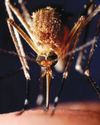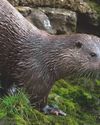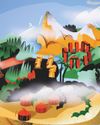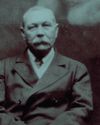
A furry animal with a body the size of a hot-water bottle is cavorting through the waters of a clear, blue stream emerging from Jenolan caves, three hours west of Sydney. There is a splash as it dives down, paddling vigorously with its webbed front feet. When it reaches the bottom, the animal begins sweeping its flat, duck-like bill back and forth above the silt. The platypus is using thousands of minute receptors in its bill to detect the electrical fields made by the muscle movements of its prey – mainly insect larvae, aquatic insects, and sometimes freshwater crayfish and shrimp.
It is relatively easy to spot a platypus in the limpid stream and Blue Lake at Jenolan, but normally they are far harder to detect. Their waterproof brown coats offer good camouflage against the earthy banks of the permanent rivers, creeks, lakes and wetlands they inhabit in eastern Australia.
They’re also largely nocturnal, and usually spend the day sleeping in their burrows, which may be up to 30m long, in the river banks. They emerge at dusk to hunt for their aquatic prey and retreat at dawn. Females weigh 600–1,750g, while males are a heftier 800–3,000g (platypuses in north Queensland are about half the weight of those in Tasmania).
This curious creature is a monotreme: a form of egg-laying mammal that suckles its young. It has a single orifice – the cloaca – used for urination, defecation and reproduction. The only other monotremes are four species of echidna, but these are very different looking, spiny land dwellers.
Tom Grant, author of the natural history guide Platypus, spent over 40 years researching platypuses on a 5km stretch of the Shoalhaven River in New South Wales. He microchipped 812 individuals and found the oldest female platypus in his study was still breeding after 21 years.
WOULD YOU BELIEVE IT?
Denne historien er fra November - December 2019-utgaven av BBC Earth.
Start din 7-dagers gratis prøveperiode på Magzter GOLD for å få tilgang til tusenvis av utvalgte premiumhistorier og 9000+ magasiner og aviser.
Allerede abonnent ? Logg på
Denne historien er fra November - December 2019-utgaven av BBC Earth.
Start din 7-dagers gratis prøveperiode på Magzter GOLD for å få tilgang til tusenvis av utvalgte premiumhistorier og 9000+ magasiner og aviser.
Allerede abonnent? Logg på

World's First Malaria Vaccine
The World Health Organization’s director-general hails ‘historic moment’ as mass immunisation of African children begins

Is River Pollution Putting The Species In Jeopardy Again?
Ten years ago, it was jubilantly announced that o ers had returned to every county in England. But is river pollution putting the species in jeopardy again?

The Big Burnout
Long hours, low pay and a lack of appreciation — among other things — can make for a stressful workplace and lead to burnout. It’s something we should all be concerned about, because over half of the workforce reports feeling it

Putting Nature To Rights
More countries are enshrining the right to a clean environment into law. So if a company or government is impinging upon that right, you could take them to court

Mega Spaceship: Is It Possible For China To Build A Kilometre-Long Spacecraft?
Buoyed on by its successful Moon missions, China has launched a five-year study to investigate the possibility of building the biggest-ever spacecraft

Are We Getting Happier?
Enjoying more good days than bad? Feel like that bounce in your step’s getting bigger? HELEN RUSSELL looks into whether we’re all feeling more cheery…

“Unless the Japanese got the US off their backs in the Pacific, they believed they would face complete destruction”
Eighty years ago Japan’s surprise raid on Pearl Harbor forced the US offthe fence and into the Second World War. Ellie Cawthorne is making a new HistoryExtra podcast series about the attack, and she spoke to Christopher Harding about the long roots of Japan’s disastrous decision

Your Mysterious Brain
Science has mapped the surface of Mars and translated the code for life. By comparison, we know next to nothing about what’s between our ears. Over the next few pages, we ask leading scientists to answer some of the most important questions about our brains…

Why Do We Fall In Love?
Is it companionship, procreation or something more? DR ANNA MACHIN reveals what makes us so willing to become targets for Cupid’s arrow

Detecting the dead
Following personal tragedy, the creator of that most rational of literary figures, Sherlock Holmes, developed an obsession with spiritualism. Fiona Snailham and Anna Maria Barry explore the supernatural interests of Sir Arthur Conan Doyle